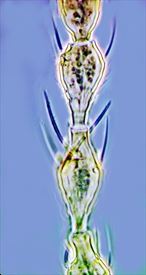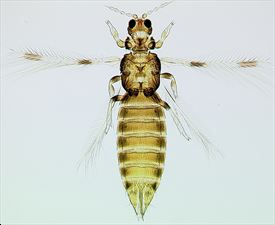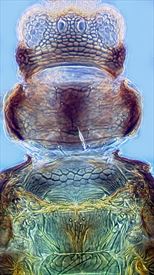Distinguishing features
Both sexes fully winged. Body brown, head yellow at anterior; legs yellow, mid and hind femora brown; antennal segments III–V largely yellow; fore wing with extensive pale area medially between two darker bands. Head reticulate with transverse occipital ridge; ocellar setae III on anterior margins of triangle; three pairs of postocular setae present. Antennae 8-segmented, III and IV each with sense cone forked. Pronotum with no long setae. Metanotum irregularly reticulate medially, median setae arise medially. Tarsi 2-segmented. Fore wing with two complete rows of setae, posteromarginal cilia wavy. Abdominal tergites weakly reticulate medially, median pair of setae small; posterior margins without a craspedum, VIII with comb of microtrichia laterally; tergite X with longitudinal split almost complete.
Male similar to female; tergite IX with 3 pairs of stout, thorn-like setae dorsally; sternites III–VII with a minute (4 micron) transverse pore plate near anterior margin.
Related species
Nine species are recognized in the genus Hercinothrips, all of them originally from Africa. Two are now widespread around the world, but a third, H. dimidiatus, was found in Portugal in 2015 causing damage to cultivated Aloe arborescens. H. bicintus is very similar to H. femoralis, but has the fore wings more extensively pale medially. Hercinothrips species are unusual amongst Panchaetothripinae in having 2-segmented tarsi, and the fore wing with both longitudinal veins bearing a complete row of setae.
Biological data
This species has been found on many different plant species, with no obvious pattern. Adults and larvae are sometimes abundant on older leaves; often breeding on banana fruits where these are touching in a developing hand (Mound & Wells, 2015). In New Zealand this species is recorded from a wide variety of introduced plants, including Solanum nigrum, Cucurbita spp., Zantedeschia aethiopica, Escallonia macrantha and Coprosma robusta. At Waitara (TK) it was found damaging the midrib area on the underside of Solanum aviculare leaves.
Distribution data
Originally from Africa but now recorded from many tropical and subtropical countries, and also sometimes a pest in greenhouses in temperate countries. In New Zealand collected from Three Kings Islands / ND, AK, CL and TK. Collected from November to April in NZ.
Family name
THRIPIDAE, PANCHAETOTHRIPINAE
Species name
Hercinothrips bicinctus (Bagnall)
Original name and synonyms
Heliothrips bicinctus Bagnall, 1919: 258
Heliothrips bifasciipennis Girault, 1926: 1
References
Martin NA (2017) Banana silvering thrips - Hercinothrips bicinctus. http://nzacfactsheets.landcareresearch.co.nz/factsheet/InterestingInsects/Banana-silvering-thrips--Hercinothrips-bicinctus.html
Mound LA & Wells A (2015) Endemics and adventives: Thysanoptera (Insecta) Biodiversity of Norfolk, a tiny Pacific Island. Zootaxa 3964 (2): 183–210.
Mateus C, Franco JC, Caetano MF, da Silva EB, Ramos AP, Figueiredo E & Mound L (2015) Hercinothrips dimidiatus Hood (Thysanoptera: Thripidae), a new pest of Aloe arborescens Miller in Europe. Phytoparasitica 43(5): 689–692.
zur Strassen R (2003) Die terebranten Thysanopteren Europas und des Mittelmeer-Gebietes. Die Tierwelt Deutschlands 74: 1–271.





